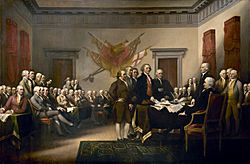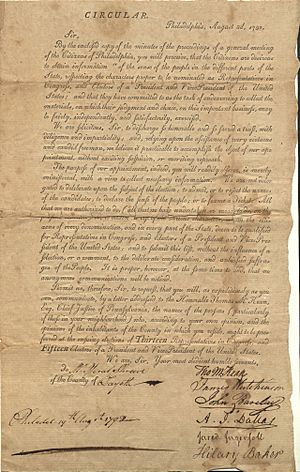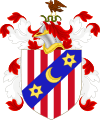Thomas McKean facts for kids
Quick facts for kids
Thomas McKean
|
|
|---|---|
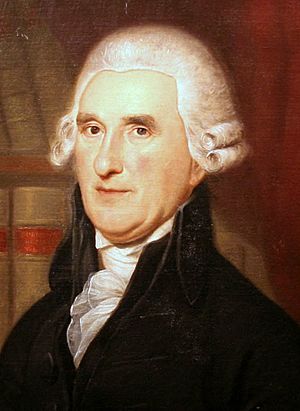
Portrait by Charles Willson Peale
|
|
| 2nd Governor of Pennsylvania | |
| In office December 17, 1799 – December 20, 1808 |
|
| Preceded by | Thomas Mifflin |
| Succeeded by | Simon Snyder |
| Chief Justice of Pennsylvania | |
| In office July 28, 1777 – December 17, 1799 |
|
| Preceded by | Benjamin Chew |
| Succeeded by | Edward Shippen IV |
| 8th President of the Continental Congress | |
| In office July 10, 1781 – November 4, 1781 |
|
| Preceded by | Samuel Huntington |
| Succeeded by | John Hanson (as 1st President of the Confederation Congress) |
| Continental Congressman from Delaware |
|
| In office December 17, 1777 – February 1, 1783 |
|
| In office August 2, 1774 – November 7, 1776 |
|
| 2nd President of Delaware | |
| In office September 22, 1777 – October 20, 1777 |
|
| Preceded by | John McKinly |
| Succeeded by | George Read |
| Personal details | |
| Born | March 19, 1734 New London Township, Province of Pennsylvania, British America |
| Died | June 24, 1817 (aged 83) Philadelphia, Pennsylvania, U.S. |
| Resting place | Laurel Hill Cemetery, Philadelphia |
| Political party | Federalist Democratic-Republican |
| Spouses | Mary Borden Sarah Armitage |
| Residences | New Castle, Delaware Philadelphia, Pennsylvania |
| Profession | lawyer |
| Signature |  |
Thomas McKean (March 19, 1734 – June 24, 1817) was an important American lawyer and politician. He is known as one of the Founding Fathers of the United States. During the American Revolution, he represented Delaware in the Continental Congress. There, he signed important documents like the United States Declaration of Independence.
McKean held many public jobs throughout his life. He was the President of Congress for a time. He also served as the president of Delaware. Later, he became the chief justice of Pennsylvania and then the governor of Pennsylvania.
Contents
Early Life and Family
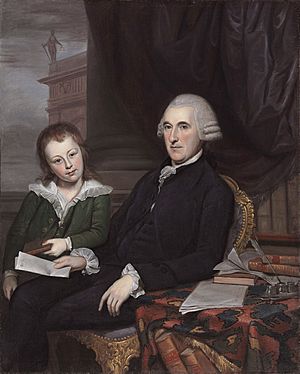
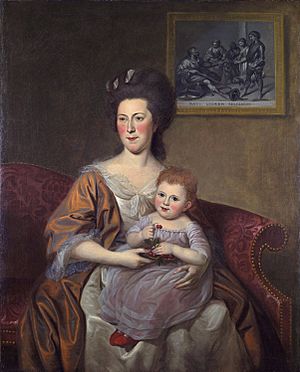
Thomas McKean was born in 1734 in New London Township, Pennsylvania. His parents, William McKean and Letitia Finney, were Irish immigrants. His father ran a tavern.
Thomas McKean married Mary Borden in 1763. They lived in New Castle, Delaware and had six children. Mary died in 1773.
In 1774, McKean married Sarah Armitage. They lived in Philadelphia, Pennsylvania, and had four children. Their daughter, Sarah, married a Spanish diplomat. Their grandson later became the Prime Minister of Spain.
Starting His Career
McKean started his education at the New London Academy. When he was 16, he began studying law with his cousin. By 1755, he was allowed to practice law in Delaware. The next year, he could practice in Pennsylvania too.
In 1756, he became a deputy attorney general for Sussex County, Delaware. From 1762 to 1776, he was a member of Delaware's General Assembly. He even served as its speaker in 1772-1773. He also worked as a judge and a customs collector.
In 1765, his court made a rule that all court papers had to be recorded on "unstamped paper." This was a way to protest the Stamp Act, a British tax on paper.
Political Groups in Delaware
In the 1700s, Delaware had two main political groups. The "Court Party" usually supported the British government. The "Country Party" wanted independence from Britain. Thomas McKean was a strong leader of the Country Party. He worked with Caesar Rodney and often disagreed with his friend George Read.
The Stamp Act Congress
In 1765, McKean and Caesar Rodney represented Delaware at the Stamp Act Congress. This was a meeting where colonies protested the Stamp Act. McKean suggested that each colony should have one vote, no matter its size. This idea was later used in the Continental Congress and is still seen today in the United States Senate.
McKean was very important at this Congress. He helped write a letter to the British Parliament. When some members refused to sign the letter, McKean strongly argued with them.
The American Revolution
Even though he lived in Philadelphia, McKean was a key leader for independence in Delaware. He was a delegate for Delaware in the First Continental Congress in 1774 and the Second Continental Congress in 1775 and 1776.
McKean strongly believed in independence. He helped convince others to vote to break away from Great Britain. In June 1776, when Congress was voting on independence, Delaware's vote was tied. McKean asked Caesar Rodney to ride all night from Dover to cast his vote. Rodney arrived just in time, and Delaware voted for independence.
After the vote on July 2, McKean helped write the United States Declaration of Independence. It was approved on July 4.
A few days later, McKean left Congress to lead a militia unit called the Pennsylvania Associators. He joined General George Washington's army in New York. Because he was away, McKean was not there when most people signed the Declaration of Independence on August 2, 1776. He signed it later, possibly as late as 1781.
In October 1776, the Delaware General Assembly did not re-elect McKean to Congress. But after the British took over parts of Delaware, opinions changed. McKean was sent back to Congress in October 1777. During this time, British forces often chased him. He had to move his family five times to stay safe.
He stayed in Congress until 1783. McKean helped write the Articles of Confederation, which was the first constitution of the United States. In July 1781, he was elected as the President of Congress. This job was mostly for show, but he handled many letters and signed official papers. While he was president, the British army surrendered at Yorktown, which ended the war.
Leading Delaware
McKean also led Delaware's effort to declare independence from Britain. Delaware did this on June 15, 1776. In August, he was chosen to help write a new state constitution. McKean rode from Philadelphia to Dover, Delaware in one day. That night, he wrote most of the document himself. It was approved on September 20, 1776. The Delaware Constitution of 1776 was the first state constitution written after the Declaration of Independence.
McKean was elected to Delaware's first House of Assembly. He became speaker in February 1777. When President John McKinly was captured by the British, McKean served as the acting president of Delaware for about a month. He managed to keep order and recruit militia during this difficult time.
Leading Pennsylvania
McKean became the chief justice of Pennsylvania on July 28, 1777. He held this job for a long time, until 1799. He helped create the rules for justice in Pennsylvania. He believed that courts had the right to strike down laws that were against the constitution. This idea, called judicial review, was later adopted by the U.S. Supreme Court. He also worked to protect the rights of people accused of crimes.
He helped Pennsylvania ratify (approve) the Constitution of the United States. At first, he was a Federalist, believing in a strong central government. But later, he joined the Democratic-Republican Party, led by Thomas Jefferson.
The Whiskey Rebellion
As chief justice, McKean was involved in the Whiskey Rebellion in 1794. This was a protest by farmers against a tax on whiskey. President George Washington and his advisors discussed how to handle it. McKean argued that the courts should deal with the rebels, not the military. However, he also believed the government needed to stop the rebellion from spreading.
Governor of Pennsylvania
McKean was elected governor of Pennsylvania and served three terms, from 1799 to 1808. He won easily in 1799 and 1802. When he first became governor, he removed Federalists from state jobs. This practice is sometimes called the "spoils system."
In 1805, he ran for a third term. Some people in his own party did not support him. So, McKean teamed up with Federalists to win the election. After that, he started removing some of his former party members from jobs.
Some newspapers and politicians criticized McKean strongly. They even tried to impeach him (remove him from office) in 1807, but it did not happen.
McKean also worked to expand free education for everyone. When he was 80 years old, he helped organize a defense group in Philadelphia during the War of 1812. He spent his retirement writing and discussing politics. He had become very wealthy from his investments.
Death and Legacy
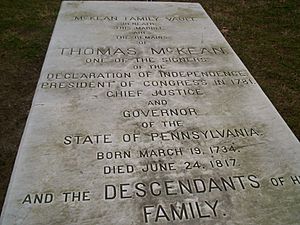

Thomas McKean died in Philadelphia on June 24, 1817. He was first buried in the First Presbyterian Church Cemetery. Later, his body was moved to Laurel Hill Cemetery.
Several places are named after him, including McKean County, Pennsylvania, and Thomas McKean High School in Delaware. There are also streets and dorms named for him at universities.
Interestingly, "Keap Street" in Brooklyn, New York, was supposed to be named after him. But the planners misread his signature, thinking "McKean" looked like "Keap."
McKean was a tall man, over six feet. He was known for being quick-tempered and strong-willed. John Adams, another Founding Father, said McKean was one of the few people in Congress who could "see more clearly to the end of the business."
In Popular Culture
In the 1969 Broadway musical 1776, Thomas McKean is shown as a tough, older Scot who argues with George Read. In real life, McKean and Read were often on opposite political sides. However, McKean was not a Scottish immigrant. His parents were Irish Protestants. In the 1972 film version of the musical, his name was mispronounced.
Images for kids
-
Governor Thomas McKean and his son, Thomas McKean, Jr. (Charles Willson Peale, 1787)
-
Sarah Armitage McKean with their daughter Maria Louisa (Charles Willson Peale, 1787)
-
Thomas McKean gravestone in Laurel Hill Cemetery
-
The Memorial to the 56 Signers of the Declaration of Independence in Washington, D.C., McKean's depicted signature is centered, bottom


